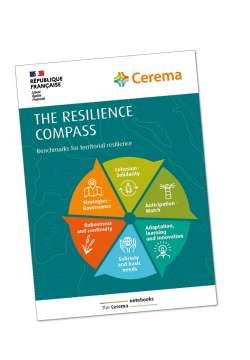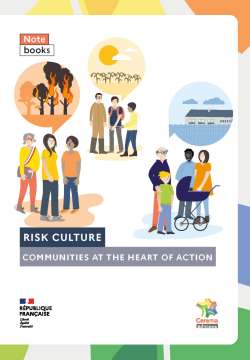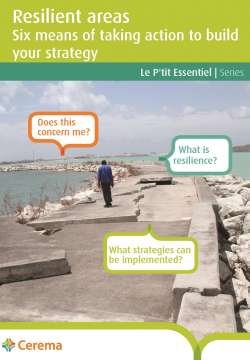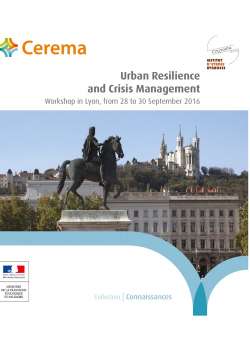
The resilience compass - Benchmarks for territorial resilience
The Covid-19 pandemic reminds us that shocks and crises often take unpredictable forms. Communities, are experiencing their great vulnerability, but at the same time reveal their coping and adaptation capacity, in the hope of being better prepared for future crises.
These Cerema notebooks support these dynamics through the resilience compass, which is intended to help the stakeholders in the territories who are constantly aware of the challenges to be met.
The Cerema resilience compass presented in this guide constitutes, in this context, a framework for reflection and action. It is intended to help the stakeholders of the community and, more broadly, of the territory (companies, local stakeholders, inhabitants, etc.), strengthen their resilience to better anticipate, act, bounce back, transform over time and, ultimately, to reduce their vulnerabilities.
The compass is thus suitable for any type of territory (city, inter-municipality, district, department, region, catchment, natural park, coastal strip, etc.) or organisation (community, company, public establishment, association, etc.). It aims for example to feed the reflections of the territory by shedding light on its degree of maturity on the subject.
It allows any public policies; approaches, project or existing or planned actions to be considered from a resilience standpoint. It reveals their contribution to the overall resilience of the territory and helps identify avenues for improvement. More generally, it can support the implementation and monitoring of sustainable territorial projects, by making it possible to integrate all the components of resilience into these projects.
Finally, the resilience qualities described in the annex can also serve as a reading grid to strengthen the resilience of projects, public policies or processes. The methods for using the resilience compass are therefore not set in stone at this stage and will be the subject of exploration and capitalisation.
A resilience compass
> Why? Who's it for?
> Where does it come from?
> Towards resilient and sustainable territories
The compass: 6 principles and 18 levers
1. Integrated and adaptive strategies and governance
> Ensuring shared governance and citizen participation
> Ensuring multi-scale cooperation between territories
> Integrating vulnerabilities and their developments into all projects
2. Social cohesion and stakeholder solidarity
> Relying on a shared culture and local know-how
> Supporting solidarity and consideration for the most vulnerable
> Guaranteeing trust and the ability to act
3. Anticipation, knowledge, watch
> Knowing the hazards, vulnerabilities and dependencies
> Informing, educating, developing a common culture of resilience
> Preparing for crisis and post-crisis management
4. Adaptation, learning and innovation
> Monitoring, alerting
> Providing regular feedback and benchmarks
> Innovating, experimenting, building new images
5. Sobriety and meeting basic needs
> Identifying and guaranteeing the basic and vital needs for all
> Supporting the transition towards a diversified, inclusive and sustainable economy
> Respecting planetary limits, natural and common resources
6. System robustness and continuity
> Limiting exposure to hazards
> Reinforcing system strength and reliability
> Guaranteeing the continuity of critical networks, services and essential activities
The eight qualities of territorial resilience
Bibliography
Contacts





